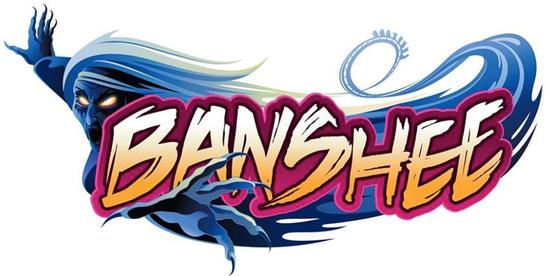
What caught my eye more than the seven inversions and 4,000+ feet of track was this line from the attraction’s press release: “The first female-inspired thrill ride at a Cedar Fair Entertainment amusement park.”
A banshee is a mythical fairy-woman (commonly found in Irish folklore) that is said to appear near those who are about to die, particularly those in a violent way such as in battle. It is not uncommon for the banshee to not be seen -- but heard -- or, so the story goes.
My first question was whether that was true -- we know that when Cedar Fair first acquired the old Paramount parks (Kings Island being among them) there were several Top Spin attractions themed to the Tomb Raider franchise, which Robert noted in his original announcement post. But to say those wipe out their claim would seem a bit unfair; after all, Cedar Fair didn’t build the Lara Croft inspired attractions. Heck, they certainly didn’t waste any time re-theming them when the license expired.
Okay, so that claim stands; so the next question is: how many male themed attractions has Cedar Fair built?
Well, not many, to be honest. Cedar Fair isn’t in the business of paying for independent properties (or IP’s as they’re called in the biz) which is typically where male attractions come from. Think Indiana Jones, Spider-Man or Harry Potter. Cedar Fair doesn’t have any of those -- most of their attractions are themed to “things” (Wicked Twister, Flight Deck [let’s get a little jab in at that whopper of a roller coaster name]) or animals (The Bat, Diamondback, et. al).
The only major attractions that could fit into the male-centric category are Ghostrider, Renegade and MAYBE Maverick. That’s companywide -- and one could argue that these attractions are as much horse-themed as they are cowboy-themed. Perhaps Cedar Fair should have announced this as the first gender-themed attraction in their history!
If you look around the theme park industry a bit, you’ll notice that there is seldom a female-centric attraction to be found. Wonder Woman has yet to make her mark at a Six Flags park, Spider-Girl isn’t rushing into a Universal property anytime soon [there is Storm Force Accelatron - Editor] and one could argue that the princess-themed attractions at the Disney parks hardly depict women in a strong or positive light.
Though Kings Island appears to be depicting a banshee as a horrifying creature more than a semi-human fairy, we’ll take what we can get. To be fair, while a banshee is typically not the cause of someone’s death, hearing a banshee’s cry is (fairly) associated with a poor outcome for the hearer.
If Cedar Fair really wanted to take a stand in this area, they would build a roller coaster themed to a female gunslinger. Aren’t 90 percent of Cedar Fair’s themed attractions themed to the old west anyway? One more can’t hurt.
So is this Cedar Fair taking a stand in favor of empowering women in their theme parks? A ploy to appeal to women, a large portion of their customer base?
Probably not.
If we review the story arc of theme park marketing over the past 30 years, we’ll find that there has been one constant throughout it all: The claim to be the tallest, the fastest or, well, first. It’s like a disease. Instead of hyping an attraction based on its individual merits, theme parks have cannibalized themselves by using other attractions as measuring sticks. They have effectively conditioned their customers to accept nothing but something better than the last something.
Remember, these are the same geniuses that thought building a $15 million roller coaster every year was a sustainable business model. Ah, the late 90’s/early 2000s. Good times for theme park fans.
What we are seeing in the Banshee announcement is an extension of that theory. Cedar Fair has found a way to make a splash and get people talking about their new ride -- heck, I’m talking about it right now! Progressivism is trendy these days and the cynic in me is hesitant to say we’re making real progress on issues like women’s rights and Cedar Fair found a way to cash in on it. Marketing with progressivism as a convenient side effect? That’s an easy pill for a marketing department to swallow.
Tweet
I feel comfortable qualifying that as a "non-major" attraction, but, well, it exists.
@AnonMouse: Sure, the rides are inanimate objects, but the stories behind the rides often feature human (or in this came, human-like) characters. Indiana Jones: The Temple of the Forbidden Eye is certainly an "it," but it's about a male hero saving our tails.
As for Six Flags, Six Flags New England has Catwoman's Whip, a family coaster that was formerly Poison Ivy's Twisted Train. Both are female villains from Batman. So female themed coasters and rides are indeed more rare, but they do definitely exist.
Then there's Cedar Point, where the fanboys give the coasters pet names like Maggie and Millie :)
The Intimidator coasters are a good point, though -- I had forgotten they were named after Earnhardt.
As far as coasters being "she's" -- while I get where you're coming from, referring to inanimate objects as "she's" does more harm towards women than good because it reinforces the "women are objects" trope; not to mention that these objects are predominantly controlled by men.
This article has been archived and is no longer accepting comments.
Good article about the old arms race and the desperate search for that USP